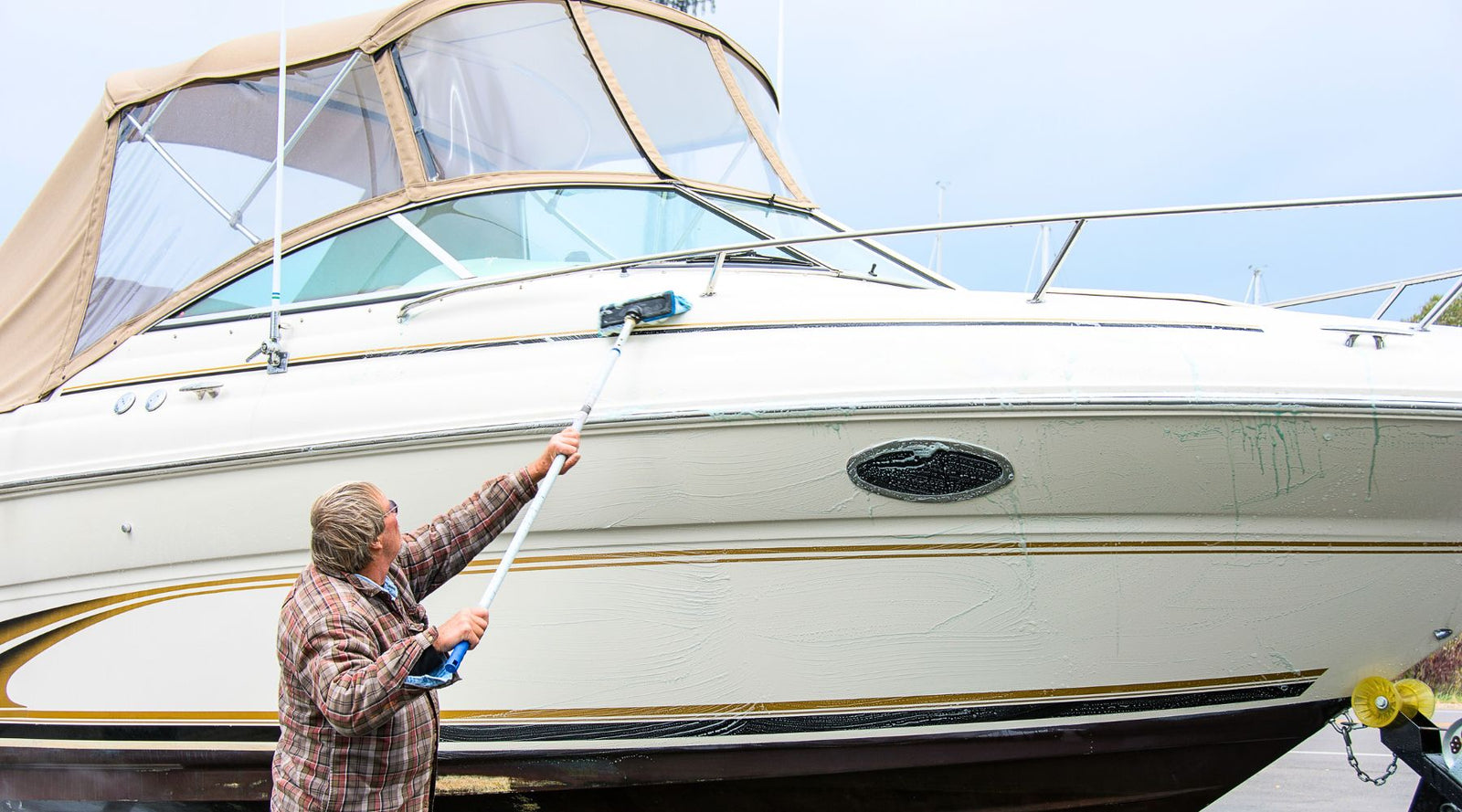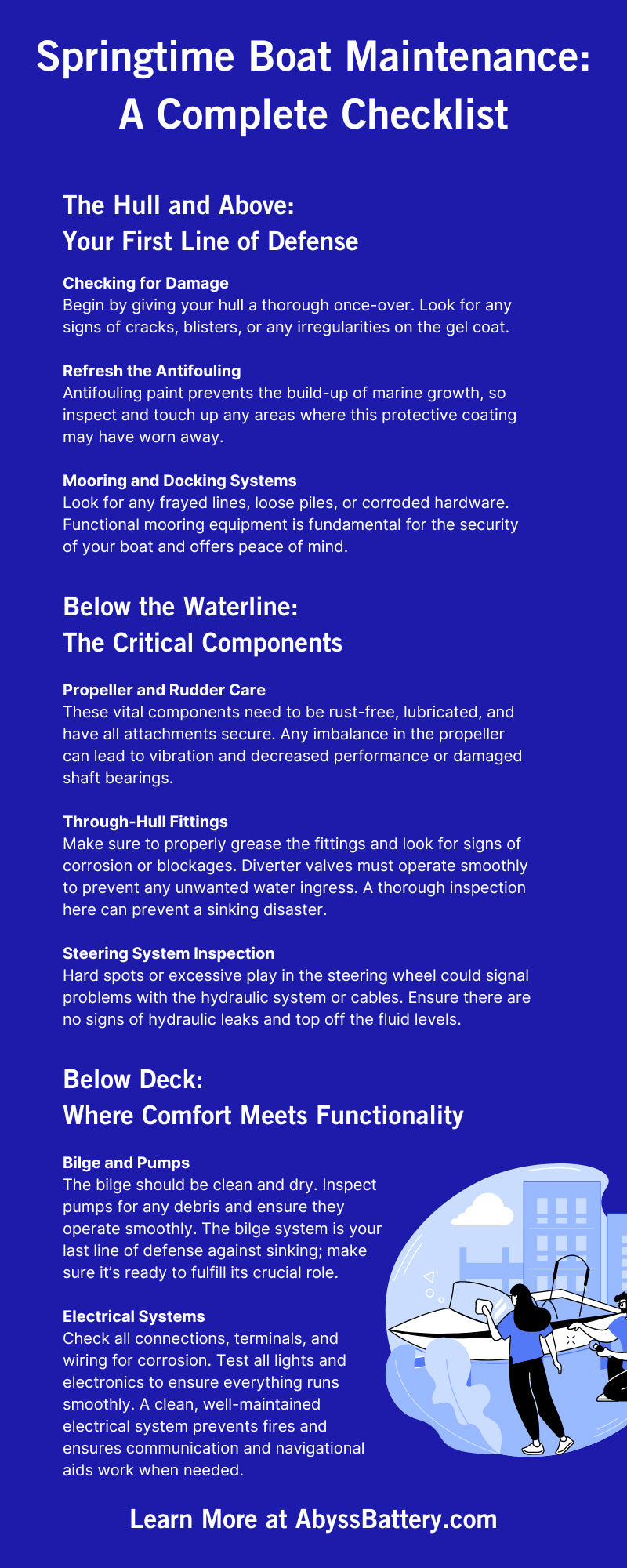Springtime Boat Maintenance: A Complete Checklist

There’s something about spring that beckons the soul to the serenity of open waters. Whether you’re a professional sailor, an avid water sports enthusiast, or just getting started with your own little watercraft, your vessel’s well-being depends on a thorough springtime inspection. Complete with a detailed checklist, this guide will help you sail through the comprehensive tasks necessary for springtime boat maintenance.
Preparing for the Changing Season
Spring goes quickly, but it’s the perfect opportunity to revive your boat after the winter hiatus. The weather is usually ideal for performing external checks, and if repairs are necessary, there’s plenty of time before the peak of boating season. Neglecting maintenance can lead to inconveniences, sometimes when you’re far from shore, and preventing these problems now can ensure a carefree summer on the water.
The Hull and Above: Your First Line of Defense
Your boat’s hull and upper structure are the most exposed to salt, freshwater, and UV rays. These elements can cause significant damage if not maintained properly.
Checking for Damage
Begin by giving your hull a thorough once-over. Look for any signs of cracks, blisters, or any irregularities on the gel coat. These issues could indicate underlying structural problems that need immediate attention. A pressure wash will reveal any hidden flaws and give your boat a fresh start for the season.
Refresh the Antifouling
Antifouling paint prevents the build-up of marine growth, so inspect and touch up any areas where this protective coating may have worn away. A clean hull means better fuel efficiency, smoother gliding through the water, and less strain on your engine.
Mooring and Docking Systems
Your boat can sustain considerable wear and tear even when docked or moored. Look for any frayed lines, loose piles, or corroded hardware. Functional mooring equipment is fundamental for the security of your boat and offers peace of mind.
Below the Waterline: The Critical Components
Many essential systems within your boat require careful inspection and maintenance in the spring.
Propeller and Rudder Care
These vital components need to be rust-free, lubricated, and have all attachments secure. Any imbalance in the propeller can lead to vibration and decreased performance or damaged shaft bearings.
Through-Hull Fittings
Make sure to properly grease the fittings and look for signs of corrosion or blockages. Diverter valves must operate smoothly to prevent any unwanted water ingress. A thorough inspection here can prevent a sinking disaster.
Steering System Inspection
Hard spots or excessive play in the steering wheel could signal problems with the hydraulic system or cables. Ensure there are no signs of hydraulic leaks and top off the fluid levels.
Below Deck: Where Comfort Meets Functionality
A well-maintained interior makes for a much more enjoyable boating experience.
Bilge and Pumps
The bilge should be clean and dry. Inspect pumps for any debris and ensure they operate smoothly. The bilge system is your last line of defense against sinking; make sure it’s ready to fulfill its crucial role.
Electrical Systems
Check all connections, terminals, and wiring for corrosion. Test all lights and electronics to ensure everything runs smoothly. A clean, well-maintained electrical system prevents fires and ensures communication and navigational aids work when needed.
Interior Cabin
Ventilation is key to preventing mold and mildew, so airing out the cabin is an important step. Inspect every cushion, fabric, and porous material for signs of dampness or mold. A light steam clean can restore freshness and prevent health hazards.
The Heart of the Vessel: The Engine
The heart of your boat is the engine, and taking care of it in the spring can prevent any summer disasters.
Fluid Levels and Changes
Check and top up or change all essential fluids, including oil, coolant, and fuel filters. Clean any filters that need it and keep an eye out for leaks. A properly lubricated engine prolongs its life and improves performance.
Belts and Hoses
Examine belts for any cracks or frays and ensure the tension is right. Inspect hoses for leaks, bulges, or soft spots that could lead to a breakdown. It’s cheaper and less stressful to replace these now than on the water.
Propulsion and Control
Your engine should start and idle smoothly. The throttle and gear controls need to work correctly. Lubricate any linkages and moving parts to avoid stiff controls that can hinder your maneuverability.
Safety and Security: Ensuring a Smooth Journey
No matter how well you maintain your boat, accidents happen. Performing safety checks is an essential task for anyone preparing to set sail.
Navigation Tools
Update charts and ensure all navigational equipment, from GPS to compass to depth finders, is in working order. The best route in the world is of no use if you can’t find it.
Safety Equipment
Verify the integrity and functionality of life jackets, fire extinguishers, flares, and signaling devices. All items should be within their expiration or service dates. Every boater should own a VHF radio—ensure it works and you know how to use it.
The Plan in Place
Review your float plan or create one if you haven’t before. This simple step can save precious time in an emergency. Make sure someone onshore knows where you are going and when to expect your return.
End-of-Season Storage: Keeping the Goodness in
Properly storing your boat at the end of the season paves the way for an easier, stress-free spring comeback. Each of these steps is an investment in the longevity of your boat.
The Clean and Dry Approach
Give your boat a thorough wash down with a good boat cleaning solution that’s environmentally friendly. Dry it out completely to prevent mold and mildew.
Engine Winterization
Drain and replace oils and lubricate all moving parts. Store your engine with the gas tank nearly empty to prevent ethanol-related issues.
Off-Season Cleaning and Maintenance
Don’t wait until spring for a full cleaning and service. Take care of everything at the end of the season to ensure all systems are in tip-top shape for the next year.
Maintaining Your Battery During the Off-Season: A Necessity
Your boat’s battery is just as eager to sail as you are but can deteriorate over time, especially if neglected. Don’t forget to follow a few key steps at the end of the year.
Proper Storage
Disconnect and remove the battery from your boat if possible. Store it in a cool, dry place in a vertical position to prevent spillage.
Charge Regularly
Charge your battery every three months to keep it in good condition. Consider investing in a battery minder—it’s a small investment that can significantly extend the life of your battery.
Perform Maintenance
Check the fluid level in each cell and top it off with distilled water if necessary. Keep terminals clean and free of corrosion. For a 36V lithium-ion marine battery, be sure to use a compatible lithium-ion charger and avoid overcharging.
An Annual Investment in Your Boat’s Longevity
Springtime boat maintenance is an annual investment in your prized possession’s longevity and safety, and this complete checklist is your compass. Each box checked is a step closer to carefree days and nights on the water, where your only concern will be the angle of the sun on the horizon. For those venturing into the open seas, meticulous preparation can be the thin line between an unforgettable voyage and a distress call.



This is just what I needed to make sure I don’t miss anything! when hoping from one job to the other it’s easy to miss or think you have done a job when you haven’t And everything is important on a boat! So they checklists are so important.
Leave a comment